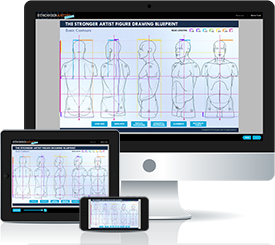CONFIDENTLY DRAW THE HUMAN FIGURE
FROM YOUR IMAGINATION
And expand your artistic range with skills that stand out from the pack
(without the
where do I begin and what comes next?” confusion, random lessons that have no rhyme or reason, or instruction that squelches your passion for art)
If you’re an artist, art student, or hobbyist looking to upgrade your art and gain outstanding results for your effort, then you probably already know that drawing the figure well is one of the most admired and marketable skills you can have.
Hello! I’m Drake Gómez, creator of the Stronger Artist website.
For 30 years I’ve taught artists like you to draw the figure with greater skill and understanding.
In fact, I’ll bet you’ve taken a drawing class or two like the ones I teach, or just tried your hand at drawing the figure from a live model or from your imagination.
If so, you probably know that drawing the human figure isn’t easy, and for many artists it’s the one skill that holds their artwork back.
Narrow that to drawing the figure from the imagination, and you probably know that many artists won't even dare try.

ALRIGHT, SMARTY-PANTS…
HERE ARE SOME THINGS YOU MIGHT NOT KNOW
Whether you've just started drawing, taken some courses, or even have a degree in art, learning to draw the figure from your imagination can:
Expand your options for careers in a range of creative industries
Figure drawing is a fundamental skill for concept artists, animators, storyboard artists, and other creative professionals in the $400 billion dollar film, television, and video game industries*. It’s also essential for comic book and graphic novel artists, cartoonists, fashion designers, and many commercial illustrators.
*2018 film revenue, box office and home entertainment, $136 billion. Source: IBISWorld; 2018 television revenue, $261.5 billion. Source: Statista; 2018 video game revenue, $43.4 billion. Source: Statista.
Distinguish your portfolio and offer you an edge over your competition
Sadly, art schools today don’t emphasize figure drawing, particularly from the imagination, and many don’t require it at all. When you can draw the figure well, you possess a skill that many artists simply don't have, so you no longer have to worry about how to make your portfolio stand out.
Improve your art in areas other than drawing
It’s often said that drawing is the bedrock for all other art forms because it trains the hand, the eye, and the brain to respond artistically in the most immediate way. Learning to draw the figure can lead to rapid improvements in figurative painting, traditional and digital illustration, sculpture, and even digital applications such as 3-D modelling.
Boost your confidence and give you more artistic freedom
Drawing without a live model or photographic reference can be daunting, but it can also boost your confidence in remarkable ways. When you can draw from your imagination, you gain artistic freedom because you're no longer tied to what you can see. Wanna impress your friends with some spontaneous drawings on the back of a napkin? If you’ve got the skills, go right ahead. (Show-off!)
Enhance the non-figurative or non-naturalistic aspects of your art
There’s an age-old belief that the visual qualities of the human figure can inform our aesthetic sensibility in general. So even if your art is abstract, expressionistic, or non-objective, your ability to draw a naturalistic figure may enhance your work. Perhaps this explains why some of the most important modern artists (hello, Picasso) were also very skilled in traditional methods of figurative drawing and painting.
THE STRANGE THING IS, EVEN THOUGH THE REASONS FOR LEARNING TO DRAW THE IMAGINED FIGURE ARE PLAIN AS DAY, THE METHOD FOR DOING SO IS ANYTHING BUT!
Draw the figure? From the imagination?? Is this really something I can learn?!
Very good question. Of course, you need to find a school or other resource that teaches this subject, and that’s not exactly easy.
Perhaps you’ve taken a figure drawing class at a college or university, community center, or private atelier. If so, you probably spent most of the time drawing from a live model.
If you dared not to draw from the model, you may have been criticized for drawing from your imagination and told that it would hurt your ability to draw from life or that it wasn’t real art.
Or maybe you found a class in drawing from the imagination, but it was an expressive drawing course. The instructor went on and on about the meaning or expressiveness of your drawings, but you wanted some feedback on your figures' proportions, anatomy, or other representational traits.
Or perhaps you’ve been trying to learn from books or videos that do teach naturalistic drawing from the imagination. But after looking at someone else’s drawings or watching someone else draw, you were left wondering what you should be doing. Copy the drawings in the book? Follow along with the video? How do you actually learn this material?
In short, you might have felt that your in-struct-ion lacked structure—that you were drowning in too many unrelated videos, diagrams, and conflicting approaches about how to draw, with no system in place for how to get from start to finish.
Want to know why most artists never learn to draw the figure from the imagination?
Very simply, without a structured learning system that takes imagined figure drawing and breaks it down into related, learnable skills and concepts, most artists get completely overwhelmed.
And once the overwhelm sets in, drawing becomes a trial-and-error process: draw an arm like this, then like that, and maybe something will eventually look right (if you don’t erase a hole in your paper first).
Inevitably, these artists grow disenchanted with drawing from the imagination, become overly self-critical, and resort to only drawing from live models or photos, or to distorted, so-called expressive drawing.
Become enchanted with drawing once again
The fact is, some people can and do draw excellent, naturalistic figures from the imagination. Through some combination of hard work, natural talent, and piecing together all of the fragmented knowledge about figure drawing, they learned to draw the figure well.
Furthermore, they learned to ignore the naysayers who dismiss naturalistic art or drawing from the imagination, the techies who think everything should be done by a computer, and the elitists who turn their noses up at any art that isn’t currently in style.
And, they didn’t give in to other limiting beliefs about what is good, bad, wise, foolish, achievable, or unlikely when it comes to art.
Which is to say, if you want to draw good, naturalistic figures from the imagination—even if you’ve taken “life drawing” classes or other art courses and still find it a struggle—the answer is yes, this really is something you can learn.
As long as you avoid getting stuck in some of the common, vicious traps that many artists fall into.
THE TOP 5 TRAPS THAT KEEP ARTISTS FROM LEARNING TO DRAW FROM THE IMAGINATION
TRAP 1
Not having a system in place
(or worse—believing you don’t need a system to draw the figure)
As an artist drawing from nothing but an image in your mind, you don’t have the luxury of looking at a human body—you have to develop knowledge of how the body should appear, in all its possible configurations.
And that knowledge—and the skills that go with it—is extensive.
Most artists gather a little information here and a little there. They read some books or magazines, watch some unrelated videos. Then they try and put all the pieces together…and get completely lost.
Though learning from a variety of sources can be healthy, you need a structured learning system to start with, and to fall back on when the going gets rough. Having a clear and effective system to guide you makes all the difference between bewilderment and understanding.
TRAP 2
Not focusing on drawing from the imagination
(or even avoiding it entirely)
Artists who've learned to draw the imagined figure have succeeded because they focused on drawing the imagined figure.
Those who struggle often assume that any kind of drawing—whether from photos, from life, or from some other source or subject—will eventually result in the ability to draw from the imagination.
The truth is, drawing the figure from the imagination is not the same as drawing from observation. Though both approaches are important, neither one results in the ability to do the other.
Figure drawing from the imagination will NEVER spontaneously come to you, no matter how many other kinds of drawing you do. You have to come to it.
TRAP 3
“Discouraging words” about drawing from the imagination
(or, Listening to the Naysayers, Part 1)
Ever have a teacher warn you against drawing from your imagination? Or even tell you that it will hurt your ability to draw from observation?
To be sure, there are often good reasons why art instructors caution students against drawing how they imagine certain objects look.
But if what you think something looks like is pretty close to what it does look like, then the picture in your mind’s eye provides a reference to compare your observations to and will actually improve your ability to draw from life.
Draw from observation, and your drawings from the imagination will improve; draw from your imagination, and your observational drawings will improve.
TRAP 4
Believing that learning to draw from the imagination is a wasted effort
(or, Listening to the Naysayers, Part 2)
Some people argue that with photos of every conceivable subject just a few clicks away, and with apps featuring poseable figures available for next to nothing, artists don’t need to spend their time and energy learning to draw from the imagination.
It’s true that drawing from the imagination takes time and effort to learn. But once you get there, it’s far more efficient than relying on photos or other images.
More importantly, though, drawing from the imagination allows your natural style to shine. Ever notice how many drawings done from photos look like…well, drawings done from photos?
Let’s recognize photos and figure posing apps for what they are—tools, which can be useful when used correctly and knowledgeably, and dangerous when not.
And whatever you do…don’t let a tool determine what you should spend your time and energy doing.
TRAP 5
Going down the anatomy rabbit hole
(and losing sight of the purpose for certain aspects of drawing)
Call them rabbit holes, black holes, or endless spirals—there are lots of these that artists can get drawn into (pun very much intended).
For some reason, anatomy is one of the worse. It’s a compelling subject, after all, as the large number of books on “anatomy for artists” suggests.
Now, understanding skeletal and muscular anatomy is important for drawing the figure—to the degree that it influences the structure, mechanics, or appearance of the body.
Unfortunately, some artists become hyper-focused on anatomy for anatomy’s sake and lose sight of the reason for it, and how much they really need to know.
So, unless you already draw the figure well and can benefit from a more detailed knowledge of anatomy, it’s not necessary to have a surgeon’s understanding of the human body. Your time is better spent on other things.
SO, LET'S JUST RECAP...
Even with all the opportunities, advantages, benefits, and enhancements that come with learning to draw good, naturalistic figures from your imagination, relatively few artists are able to do this competently.
And the main reason, as you’ve been reading, is that—IF you can find a good course that teaches this subject—there are so many pitfalls that keep artists from succeeding.
But if you can avoid these traps, you can become proficient at figurative drawing from the imagination and…
The key is to find a systematic, step-by-step, structured approach to gaining the skills and knowledge you need to draw the figure well, without recourse to live models, photos, 3-D modeling apps, poseable mannequins, or even looking in the mirror.
And if you’re the sort of person who’s willing to invest the time and effort to acquire this ability, that’s exactly what I’d like to teach you to do.
Introducing...
THE FIGURE DRAWING FRAMEWORK
Finally…I’m releasing an online program that not only teaches the skills and knowledge you need, but does so through the unique StArt Method, a proven approach that gets results fast!
The Figure Drawing Framework is not just a bunch of videos of someone demonstrating how to draw. It’s a structured learning system that breaks everything down into learnable skills and concepts, so YOU can demonstrate these skills.
There are videos, of course, but just as importantly, The Figure Drawing Framework features precise action plans for you to follow, including step-by-step tutorials, practice sheets, Crit Sheets (so you can check your work), supplements, and other resources to guide you—and steer you away from any rabbit holes. : )
Here’s what people are saying about
the course instructor
David Corrado
Author and Illustrator,
The Legend of Alastar
Drake not only has experience teaching and mentoring students, but he’s a true artist, both in and out of the classroom. He's a dedicated professional from whom I'm honored to have learned.
Judith Lynn Keats
Facilitator, educator, and artist
Transpersonal and traditional visual arts
Drake is a brilliant artist and instructor. Students of all levels will appreciate his robust knowledge, organization, thorough communication of each lesson, professional tips and suggestions, and genuine concern for his students’ individual artistic goals. Passionate and caring, Drake ensures that each student learns to draw to the best of their ability in a timely and engaging manner.
Kevin Haran
Professor
School of Visual Arts and Design
University of Central Florida
Most anyone's accomplishments sound good on paper, but I have seen the results of what Drake is doing in the studio and the quality of his students' work firsthand. Drake's breadth of knowledge and passion for art, innovation in teaching methods, and keen insight as a visual artist are among many qualities he demonstrates as a teacher.
HERE’S WHAT THE COMPLETE
FIGURE DRAWING FRAMEWORK
CONTAINS
When you enroll in The Figure Drawing Framework, you'll receive lifetime access to over 40 lessons featuring video demonstrations, step-by-step tutorials, printable resources (including practice sheets and critique sheets), and much more.
1
UNIT 1: PREPARING TO DRAW
Maximize Your Success in Learning to
Draw the Figure
So many people set out to draw with the best intentions, but crash and burn before they hardly begin. In this unit, we’ll take careful steps to ensure this doesn't happen to you, and that you get the most out of your course.
Here you’ll get a feel for everything that lies ahead, giving you a 10,000-foot view of the course and the StArt Method of drawing the figure.
Because the structure of The Figure Drawing Framework mimics the order in which a drawing proceeds from start to finish, understanding both the course and the drawing process will improve your understanding and accelerate your learning.
Plus, you'll learn about some basic supplies and how to set up your drawing space, and learn some fundamental skills for drawing in pencil.
2
UNIT 2: THE GESTURAL FIGURE
Bring Your Figures to Life
Now that you've done some warm-up drawing, it's time to bring your figures to life. That means two things: Beginning a figure drawing, but also creating a drawing that HAS a sense of life (not one that feels stiff and wooden).
The lessons in this unit focus on both goals. A blank sheet of paper can be so intimidating, and if you don't know how to start a drawing, the overwhelm can quickly set in.
But even if you do manage to get started, making your figures feel like living, moving beings who don't just stand at attention but DO things is a challenge in itself.
By the end of this unit you'll know exactly how to begin a drawing, and in a way that captures convincing gestures and actions. And, because we learn through repetition, you'll have drawn the figure enough times that you'll feel like a pro when it comes to bringing your figures to life!
3
UNIT 3: THE SCHEMATIC FIGURE
Draw Your Figures With Dead-On Precision
Once you've got a good feel for starting a figure drawing and capturing a gesture, you’re ready to begin refining your drawings to make them more precise.
Though some styles of figure drawing don't require precision, many artists WANT their figures to be accurate—but they fall short of the mark. Let's face it—even for artists who work in a semi-naturalistic style, drawing figures that don't look right is a big weakness.
This is where the StArt Method shines. As a systematic approach to drawing the figure, it breaks the process down to a set of standard viewpoints and body movements or articulations, so you can draw the figure accurately!
By the time you complete this unit, your gesture drawings won't be just expressive scribbles, but convincing poses that are correctly-proportioned and aligned. And that goes for drawings of the male and female figures, both of which are covered in this unit.
4
UNIT 4: THE VOLUMETRIC FIGURE
Make Your Figures Feel Three-Dimensional
By the time you get to Unit 4, you'll understand how to draw the imaginary figure with greater accuracy than most artists ever achieve. Now it’s time to add a sense of mass and volume to your figures.
After all, it’s a three-dimensional world you’re trying to depict, even if your figures live on a two-dimensional page.
That flatness, however, can be a hard thing to disguise.
The fact is, making your figures look three-dimensional requires fooling the viewer to a degree. But when the illusion isn't convincing, you're like a magician who blows the big trick, and no one's fooled by your work.
In this unit, you’ll learn exactly how to pull off the trick and draw the figure in a way that feels three-dimensional. This goes for drawing foreshortened views, too, which can be difficult, but that add incredible dynamism to your drawings!
5
UNIT 5: THE NATURALISTIC FIGURE
It's All in the Details
Finally, it's time to make your drawings look like natural figures rather than department store mannequins.
Too often, artists want to jump right in to the muscles and surface features of a figure. Usually this results in a hodge-podge of details that compete with one another and lack any underlying form.
By waiting until the end of this course to study these features, you will have learned to build your drawings from the inside out. And by adding the muscles and surface features to the already rock-solid framework you've drawn, you'll avoid the formless "sock filled with beans" type of figure that too many artists draw.
Bonus
But there's even more to
The Figure Drawing Framework...
As you’ve probably gathered, The Figure Drawing Framework contains a lot of information, and that information can take some time to absorb.
You’ll be forgiven if you stumble now and then trying to remember the proportions of different parts of the body, or how they should align from different views.
But rather than having to go back through the course to find what you’ve forgotten, what if you could have it all at your fingertips in an easy-to-use plan?
Well, now you can (drumroll, please)...
This is not the same Figure Drawing Blueprint that I give away as a PDF on the Stronger Artist website. This is a whole 'nuther creature—a fully interactive web application, with clickable layers you can turn on and off. And, unlike the freebie, this one includes the legs!
HIGHLIGHTS

100% Satisfaction Guarantee for 30 Days
Let me make you a challenge.
I strongly believe The Figure Drawing Framework is THE best solution for learning to draw the figure from the imagination, without the confusion, trial-and-error learning, and random lessons that cause so much frustration.
I’m also certain that you’re going to be utterly pleased with this course.
From the moment you begin The Figure Drawing Framework, you’ll be learning more than just the StArt Method for drawing the figure—you’ll be immersed in a structured learning system with precise action plans to follow, including step-by-step tutorials, practice sheets, Crit Sheets, supplements, and other useful resources.
So, here’s my challenge:
Enroll right now and begin the course.
Complete up to Lesson 03 of Unit 2. Watch the videos and complete everything in the action plans for each lesson, which will take about 8 hours.
By that point, you will have learned more about the course in the Unit 1 introductory videos and supplements. You'll also have been introduced to the unique StArt Method, have become familiar with my teaching style, and begun drawing the figure.
If you don’t feel this is an amazing start toward improving your figure drawing skills and knowledge, send me an email and show me the work you’ve done within 30 days of purchase.
You can retain the benefit of everything you’ve learned, and I’ll refund your investment.
Here’s what people are saying about the course instructor
Kong Ho
(formerly) Program Leader
Creative Arts and
Communication Department
University of Brunei Darussalam
With his artistry and competent understanding in studio art and art history, Professor Gómez demonstrates remarkable performance in his teaching and research.
Judith Lynn Keats
Title
Drake is a brilliant artist and instructor. Students of all levels will appreciate his robust knowledge, organization, thorough communication of each lesson, professional tips and suggestions, and genuine concern for his students’ individual artistic goals. Passionate and caring, Drake ensures that each student learns to draw to the best of their ability in a timely and engaging manner.
David Porter
Professor and Program Coordinator
Visual Arts Program
Keystone College (retired)
Drake is an outstanding art instructor, able to impart to art students all level of studio art skills, art history knowledge, aesthetic criticism, and artistic literacy and awareness. There are few areas of discourse he cannot address with assurance, and the depth of his knowledge is amazing.
WHAT YOU GET WHEN YOU ENROLL TODAY
The Complete
Figure Drawing Framework

Instant Lifetime Access
You get instant access to all the lessons in The Figure Drawing Framework, where you’ll learn the unique StArt Method of figure drawing from the imagination. With immediate access, you can begin your journey toward drawing the figure with confidence and exceptional skill right away!
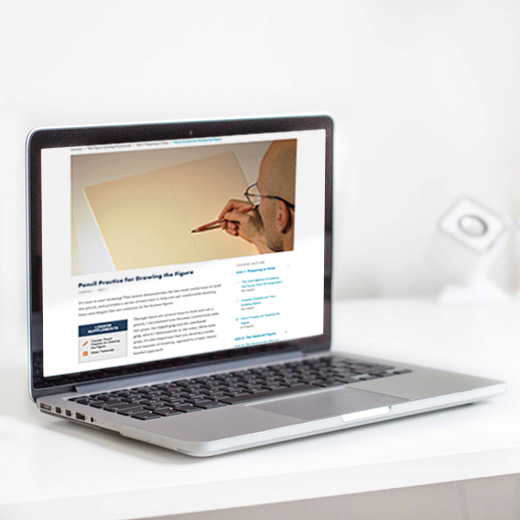
Video Demos
Every lesson features a clear and thorough video on a new drawing skill, concept, or other information. These are your starting points for each lesson, in which I show you exactly how to apply these new skills or ideas, before describing the "Action Items" you should perform to fully benefit from the lesson.
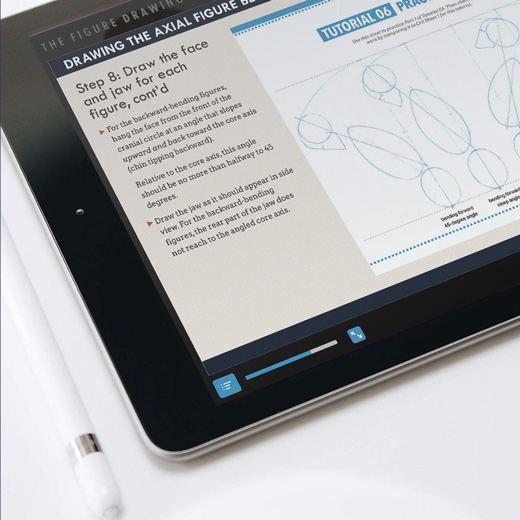
Step-by-Step Tutorials
No other drawing program on the market features step-by-step tutorials like those in The Figure Drawing Framework. Forget the frustration of needing to backtrack and find the right spot in a video—with these tutorials, you'll be guided through each lesson at your own pace, one step at a time. Advance when you're ready, stop when you're through!
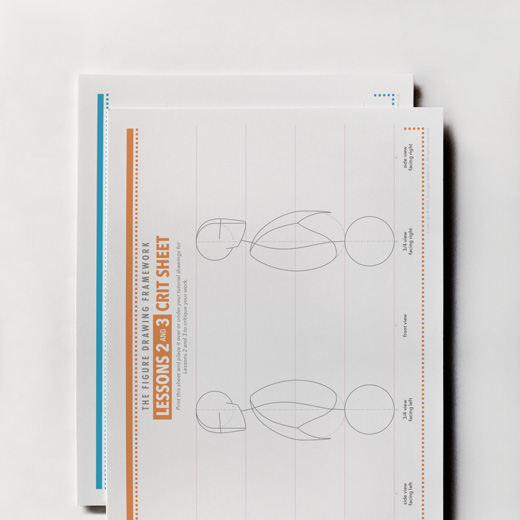
Practice Sheets and Crit Sheets
When you use one of the printable practice sheets to complete a tutorial, you can compare your results precisely to the crit sheet that accompanies the lesson. Line up the two sheets and hold them up to the light to see how you did!
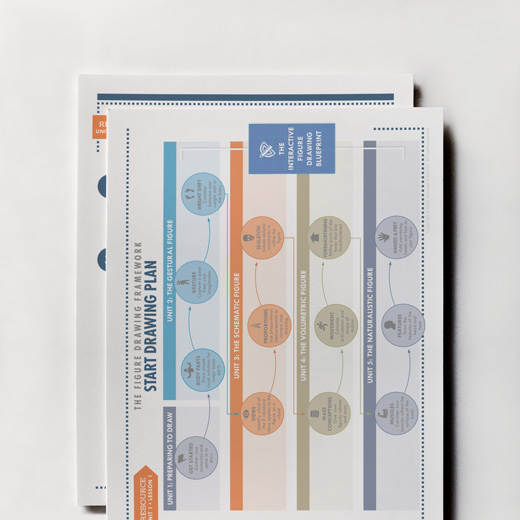
Course Resources
Many lessons include useful instructional resources that you can download and print, such as the Static Gesture Idea Sheet featuring hundreds of combined poses, views, and actions for you to draw, and the StArt Drawing Plan, which lays out the entire StArt Method stage by stage.
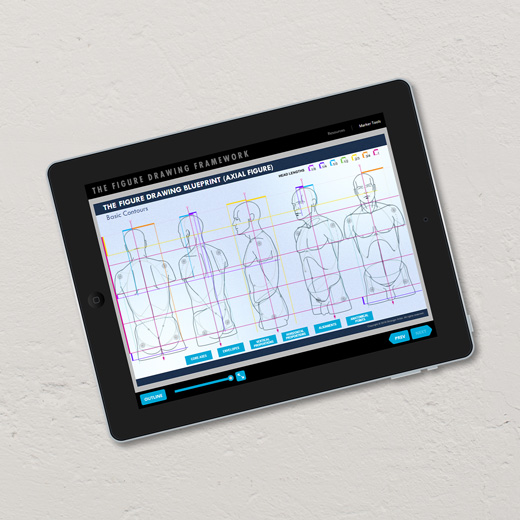
BONUS: The Interactive Figure Drawing Blueprint
You'll get access to both versions of The Figure Drawing Blueprint—the first diagramming the entire figure, and the second focusing on the torso (for when you need more detailed information). This detailed, interactive app, with clickable layers you can turn on and off, shows the most useful anatomical features, proportions, and alignments from five standard views.
The Figure Drawing Framework
one-time payment
$
247
The Figure Drawing Framework
3 monthly payments
$
97/month
Got questions? Here are some that my best students have asked before taking this course...
If you're going to invest your time and money in studying art (online or face-to-face), it's important to find a qualified instructor. I've been teaching naturalistic drawing and painting to college students for 30 years, and many of my ideas about teaching have been published in peer-reviewed journals or accepted for presentation at conferences in the arts and humanities.
Frankly, though, what matters with any instructor is that they know their subject deeply, can demonstrate their expertise, and can communicate it to others, clearly and passionately. No qualifications on paper can prove this—you have to experience it firsthand. That's why I recommend you try out The Figure Drawing Framework, and why I offer a 30-day guarantee.
If you want to know more about me, you can visit my personal website.
Because this course is based on drawing from the imagination, it is suitable for beginners. The course lessons do not assume any prior knowledge or experience with drawing, and everything is clearly explained.
Many factors go into determining how much a person can learn from any course. These include natural ability, enthusiasm, time and effort, comprehension, and yes, prior experience.
All things being equal, therefore, someone with more experience drawing may learn the course material more quickly and to a greater degree than someone with less experience. But as a self-paced course, you may take as much time as you need to fully master any lesson before going on to the next.
Each approach offers certain instructional advantages that the other doesn't. With video, you get to see a drawing progress in real time, along with how the artist actually goes about drawing. With the tutorials, you can focus on each step while working at your own pace.
For lessons that feature both a video demo and a tutorial, I recommend you watch the video first without trying to draw along with it. Then, begin the tutorial, and follow along with your own drawing.
The Figure Drawing Framework is a self-paced course, so you get to decide how much time you spend on a daily or weekly basis. To maintain some continuity from lesson to lesson, I recommend you spend at least 3-4 hours a week on the course, preferably practicing at least every other day.
Most lessons will take between one and two hours to complete, including watching the videos, doing the tutorials, and completing any other assignments. In some cases, you may want to repeat a tutorial, which will extend the time.
All told, you should be able to complete all of the course lessons in around 40-50 hours, or about 10-12 weeks.
Of course, some people will choose to spend more time each week and complete the entire course more quickly. While this is an individual choice, keep in mind that there’s a limit to how quickly anyone can acquire new skills or knowledge, so I recommend giving yourself the time to fully absorb the lessons.
No, not if you’re taught to draw from the imagination correctly. Art instructors often warn students against drawing what they think certain objects look like, and for good reason.
But if what you think something looks like is pretty close to what it does look like, then the picture in your mind’s eye provides a reference to compare your observations to and will actually improve your ability to draw from life.
No. The Figure Drawing Framework can be completed with nothing but a pencil, an eraser, and a pack of blank paper.
I do recommend you purchase a smooth drawing board so you can draw on an incline. These can usually be found for under five dollars, and I’ll tell you exactly where to go and what to buy. If you’re on a tight budget, though, the drawing board is entirely optional.
In Unit 1, I’ll cover some other optional supplies that will expose you to some different media and techniques, and offer additional learning opportunities. These supplies are inexpensive and can be commonly found in stores or online for those who are interested.
Yes. Although I teach the course using traditional media (graphite pencil and colored pencils for clarity), you can use other media, including digital media.
If you choose to work digitally, I recommend you use a digital pen or stylus (not a mouse) and a pen tablet or tablet computer that allows you to draw directly on the screen. Almost any drawing software or app will work well.
In the course videos, I use graphite pencil and colored pencil to demonstrate each lesson. Though some early lessons cover different ways to hold and manipulate the pencil, the course does not focus on rendering techniques (such as shading and blending, hatching/cross-hatching, and so on).
As the title suggests, the course emphasizes teaching a framework for drawing the figure. That means your drawings can then be completed in any number of media and techniques, depending on your interests and experience. Because the number of different media and techniques are so broad, however, they should be covered individually in a separate course or courses.
The Figure Drawing Framework emphasizes the StArt Method for drawing the figure from the imagination. This original approach to drawing features many ideas and concepts that are not taught anywhere else (unless you’ve taken one of the college courses I’ve taught).
There’s simply too much involved in the StArt Method to explain here, but if you’ve read through this web page, you’ve already gathered some of the many ways that the StArt Method differs from the approaches used in other courses.
If terms such as standard view, core axis, axial figure, cranial circle, equipoise, static contrapposto, or dynamic contrapposto are new to you, these are just a few of the unique ideas that the StArt Method teaches.
The Figure Drawing Framework does not teach a specific style of drawing. As the name says, it teaches a framework that is based on drawing the figure in an accurate, naturalistic way, but that is "agnostic" with regard to style.
A naturalistic framework means figures and other subjects in a drawing will look similar to their counterparts in reality, at least in their proportions and structure.
How those subjects are rendered to completion, however, can vary depending on your own style and desires. These styles can include everything from classical realism to more contemporary styles, and can be applied to fashion design, commercial illustration, fine art, storyboarding and concept art, comic art, and even many other end-uses.
9 WAYS TO KNOW
THE FIGURE DRAWING FRAMEWORK
IS THE PERFECT COURSE FOR YOU
You've been drawing for some time and have taken some classes, online courses, and/or studied a number of books (heck, you might even have a bona fide art school degree), but you still aren’t confident about your figure drawing skills or your understanding of what you're doing when you draw.
You’re mostly starting out, though you might have tried drawing on your own or following some books or videos. You’re also mostly confused about what you’re doing, feeling overwhelmed or frustrated, and in need of some guidance.
You're not looking for a formulaic, quick fix. You’re able and willing to invest a few hours a week toward the course so long as you know that your time and effort will result in a measurable improvement in your figure drawing skills and knowledge.
You already draw regularly but are frustrated with piecing together ideas from books and videos. You often feel you would benefit from a more structured approach to learning, where you had a complete system to follow with precise action plans.
You’re skeptical about much of what passes for art today and how it is often taught, but unsure about whether to commit to atelier-based training for learning classical realism. You want to learn a framework for drawing the figure that is “style-agnostic”—one that you can apply to rendering the figure in a variety of styles and media.
You want to become a professional artist and make a career out of art. Learning to draw well is more than just an idle pursuit—you’re seeking the most effective and efficient instruction upon which to build your future as an artist.
You’re serious about drawing but aren’t planning your livelihood around it. You want a course that is self-paced and can be paused if life gets in the way. Still, finding the highest-quality instruction is important to you, because no one wants to waste time or money.
You’re excited to try the StArt Method and be able to draw the axial figure from five different views, entirely from your imagination, within about 8 hours of starting the course.
You’re ready to take my 30-Day Challenge to find out if The Figure Drawing Framework is right for you. It’s easy—complete the course through Lesson 03 of Unit 2 to find out how the StArt Method can transform your ability to draw the figure from the imagination, or send me an email and show me your work and I’ll refund every penny of your purchase.
If you said “yes” to at least 6 of the above, I can’t wait to meet you inside The Figure Drawing Framework.
The Figure Drawing Framework
one-time payment
$
247
The Figure Drawing Framework
3 monthly payments
$
97/month
In conclusion...
I'm extremely proud of The Figure Drawing Framework. It's the culmination of over 30 years of drawing the figure and teaching hundreds of students to do the same. In short, it's the course I wish I had when I was starting out. I hope you'll take this opportunity to enroll, and to allow me to share it all with you. Thank you!
Copyright ©2020 Stronger Artist LLC. All rights reserved.


